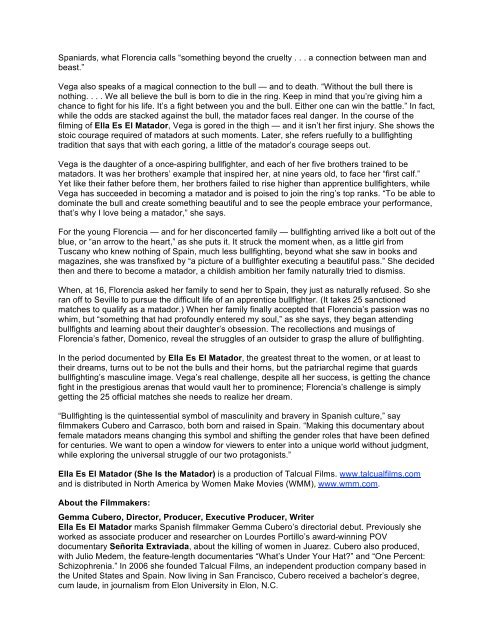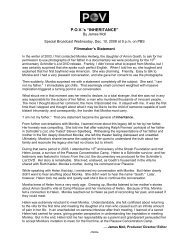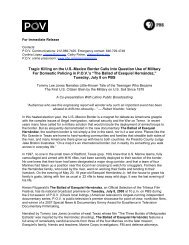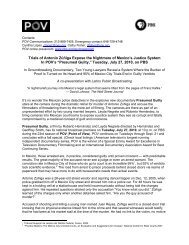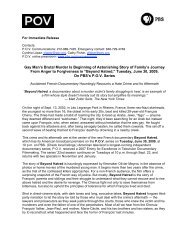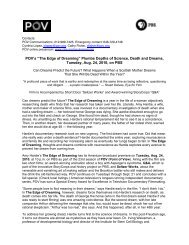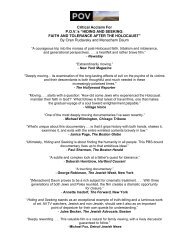Ella Es El Matador (She Is the Matador) - American Documentary, Inc.
Ella Es El Matador (She Is the Matador) - American Documentary, Inc.
Ella Es El Matador (She Is the Matador) - American Documentary, Inc.
You also want an ePaper? Increase the reach of your titles
YUMPU automatically turns print PDFs into web optimized ePapers that Google loves.
Spaniards, what Florencia calls “something beyond <strong>the</strong> cruelty . . . a connection between man andbeast.”Vega also speaks of a magical connection to <strong>the</strong> bull — and to death. “Without <strong>the</strong> bull <strong>the</strong>re isnothing. . . . We all believe <strong>the</strong> bull is born to die in <strong>the</strong> ring. Keep in mind that you’re giving him achance to fight for his life. It’s a fight between you and <strong>the</strong> bull. Ei<strong>the</strong>r one can win <strong>the</strong> battle.” In fact,while <strong>the</strong> odds are stacked against <strong>the</strong> bull, <strong>the</strong> matador faces real danger. In <strong>the</strong> course of <strong>the</strong>filming of <strong><strong>El</strong>la</strong> <strong>Es</strong> <strong>El</strong> <strong>Matador</strong>, Vega is gored in <strong>the</strong> thigh — and it isn’t her first injury. <strong>She</strong> shows <strong>the</strong>stoic courage required of matadors at such moments. Later, she refers ruefully to a bullfightingtradition that says that with each goring, a little of <strong>the</strong> matador’s courage seeps out.Vega is <strong>the</strong> daughter of a once-aspiring bullfighter, and each of her five bro<strong>the</strong>rs trained to bematadors. It was her bro<strong>the</strong>rs’ example that inspired her, at nine years old, to face her “first calf.”Yet like <strong>the</strong>ir fa<strong>the</strong>r before <strong>the</strong>m, her bro<strong>the</strong>rs failed to rise higher than apprentice bullfighters, whileVega has succeeded in becoming a matador and is poised to join <strong>the</strong> ring’s top ranks. “To be able todominate <strong>the</strong> bull and create something beautiful and to see <strong>the</strong> people embrace your performance,that’s why I love being a matador,” she says.For <strong>the</strong> young Florencia — and for her disconcerted family — bullfighting arrived like a bolt out of <strong>the</strong>blue, or “an arrow to <strong>the</strong> heart,” as she puts it. It struck <strong>the</strong> moment when, as a little girl fromTuscany who knew nothing of Spain, much less bullfighting, beyond what she saw in books andmagazines, she was transfixed by “a picture of a bullfighter executing a beautiful pass.” <strong>She</strong> decided<strong>the</strong>n and <strong>the</strong>re to become a matador, a childish ambition her family naturally tried to dismiss.When, at 16, Florencia asked her family to send her to Spain, <strong>the</strong>y just as naturally refused. So sheran off to Seville to pursue <strong>the</strong> difficult life of an apprentice bullfighter. (It takes 25 sanctionedmatches to qualify as a matador.) When her family finally accepted that Florencia’s passion was nowhim, but “something that had profoundly entered my soul,” as she says, <strong>the</strong>y began attendingbullfights and learning about <strong>the</strong>ir daughter’s obsession. The recollections and musings ofFlorencia’s fa<strong>the</strong>r, Domenico, reveal <strong>the</strong> struggles of an outsider to grasp <strong>the</strong> allure of bullfighting.In <strong>the</strong> period documented by <strong><strong>El</strong>la</strong> <strong>Es</strong> <strong>El</strong> <strong>Matador</strong>, <strong>the</strong> greatest threat to <strong>the</strong> women, or at least to<strong>the</strong>ir dreams, turns out to be not <strong>the</strong> bulls and <strong>the</strong>ir horns, but <strong>the</strong> patriarchal regime that guardsbullfighting’s masculine image. Vega’s real challenge, despite all her success, is getting <strong>the</strong> chancefight in <strong>the</strong> prestigious arenas that would vault her to prominence; Florencia’s challenge is simplygetting <strong>the</strong> 25 official matches she needs to realize her dream.“Bullfighting is <strong>the</strong> quintessential symbol of masculinity and bravery in Spanish culture,” sayfilmmakers Cubero and Carrasco, both born and raised in Spain. “Making this documentary aboutfemale matadors means changing this symbol and shifting <strong>the</strong> gender roles that have been definedfor centuries. We want to open a window for viewers to enter into a unique world without judgment,while exploring <strong>the</strong> universal struggle of our two protagonists.”<strong><strong>El</strong>la</strong> <strong>Es</strong> <strong>El</strong> <strong>Matador</strong> (<strong>She</strong> <strong>Is</strong> <strong>the</strong> <strong>Matador</strong>) is a production of Talcual Films. www.talcualfilms.comand is distributed in North America by Women Make Movies (WMM), www.wmm.com.About <strong>the</strong> Filmmakers:Gemma Cubero, Director, Producer, Executive Producer, Writer<strong><strong>El</strong>la</strong> <strong>Es</strong> <strong>El</strong> <strong>Matador</strong> marks Spanish filmmaker Gemma Cubero’s directorial debut. Previously sheworked as associate producer and researcher on Lourdes Portillo’s award-winning POVdocumentary Señorita Extraviada, about <strong>the</strong> killing of women in Juarez. Cubero also produced,with Julio Medem, <strong>the</strong> feature-length documentaries “What’s Under Your Hat?” and “One Percent:Schizophrenia.” In 2006 she founded Talcual Films, an independent production company based in<strong>the</strong> United States and Spain. Now living in San Francisco, Cubero received a bachelor’s degree,cum laude, in journalism from <strong>El</strong>on University in <strong>El</strong>on, N.C.


